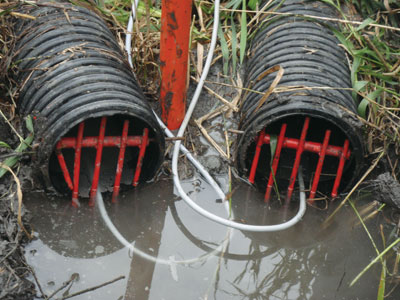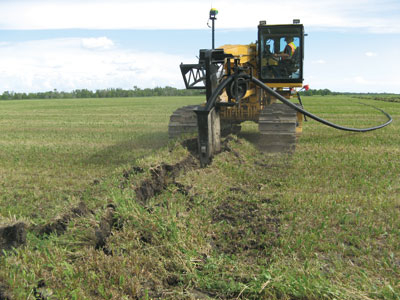
Irrigation
Tile drainage research starting in Manitoba
Chris Unrau is being patient. He thought the time for widespread adoption of tile drainage had arrived in southern Manitoba when he took over a tile drainage business in 2006. He may have been ‘ahead of the curve’ but recent events are making him hopeful again.
May 3, 2010 By John Dietz
Chris Unrau is being patient. He thought the time for widespread adoption of tile drainage had arrived in southern Manitoba when he took over a tile drainage business in 2006. He may have been ‘ahead of the curve’ but recent events are making him hopeful again.
 |
|
| Doppler flow meters measure water depth and velocity in the tile every five minutes at the Kelburn Farm. |
|
 |
|
| Tile drain installation on a heavy clay soil in July 2008 at the Kelburn Farm research site near Glenlea, Manitoba. (Photo courtesy of John Fitzmaurice, AESB)
|
Unrau is watching industry, academia and extension co-operating on the first tile drainage research in many years in Manitoba. The goal is to develop better understanding and improved designs, of field water management systems.Two research projects on new subsurface drainage installations are being launched in the province by a consortium of agencies, institutions and companies.
Tile drainage is an old procedure. It amounts to the reverse of irrigation, bringing down moisture by draining the soil from below. Tile spacing, depth, permeability and porosity regulate the moisture reduction.
One project is at JRI’s Kelburn Farm near Glenlea, a few miles south of Winnipeg and close to the west bank of the Red River. Here, in July 2008, drainage tiles were installed into the heavy clay soil with different spacing.
The second project is located on Hespler Farm Inc., south of Winkler, on loamy soil dedicated to corn and potatoes. It is an elaborate water management experiment, with tile installation to begin in late 2009 or early 2010.
The Hespler Farm project is under the supervision of Dr. R. Sri Ranjan, a professor specialized in irrigation and drainage engineering in the University of Manitoba Department of Biosystems Engineering. Two of his doctoral students, Marcos Cordeiro and Sanjayan Satchithanantham, will do the research.
Agri-Environment Services Branch of Agriculture and Agri Food Canada is heavily involved in both projects, says Bruce Shewfelt, AESB drainage and irrigation lead. AESB has assisted with developing the research protocols, has provided salinity level soil mapping, detailed soil surveys, design for tile layout and sizing, and use of specialized monitoring equipment.
Both projects have funding from the federal/provincial Agri-Food Research and Development Initiative (ARDI). Manitoba Agricultural Food and Rural Initiatives (MAFRI) and AESB plan to share the information through extension materials and workshops in the next few years.
Unrau’s company, Precision Land Solutions in Winkler, is contracted to install the perforated corrugated plastic tile in precisely placed and sloped parallel rows beneath the fields at both locations. The company achieves millimeter accuracy in slope and placement with new RTK-assisted GPS guidance.
A self-professed “technology geek,” Unrau says RTK-GPS guidance matches laser-survey methods for accuracy but does it more quickly and opens the door to greater flexibility. He is able to survey a quarter-section in a couple of hours rather than days. Later, without resetting anything or shutting down, he can plow on curves to go around obstructions like buildings, hills and trees.
Kelburn project
Brian Hellegards, manager of the Kelburn Farm, says the project will provide data for a variety of crops and water conditions. Soil on the Kelburn Farm tests at about 48 to 60 percent clay; the remainder is equally divided between sand and silt. The entire farm is dedicated to research, operating thousands of test plots each year for a variety of companies and institutions.
Kelburn Farm land is periodically flooded by the Red River; it also tends to suffer from heavy rains. Water pools on the surface, wiping out whatever is growing. Tiles are expected to drain out the water more quickly, leading to more consistent growing conditions.
Hellegards seeded late in 2009 after a major Red River flood, and then had a wet July. He still harvested a reasonable oat crop in September but needed more time to number-crunch the results.
For Unrau, tiling in clay was a new experience. It may be the first time that a Manitoba field with heavy clay content has been tile drained. Nearly all tile drains are installed in relatively porous sandy or loamy soils.
Hellegards has 18.4 hectares (40.5 acres) in the project. One field, 4.2 hectares (about 10.4 acres), has only natural drainage. Tile spacing is 10 metres on five hectares and 20 metres on another five hectares. The tile is nearly a metre deep. The remaining area is natural now, but available for a different type of drainage project. For each field, Doppler flow metres installed by AESB measure water depth and velocity in the tile every five minutes. The tiles drain into a wetland already on the farm. Water quality also will be tested.
Hellegards credits many people for coming up with the idea. He predicts the project will be watched throughout the Red River Valley, where too much moisture is often the problem.
Hespler Project
Co-operators in the larger project at Winkler include ARDI, AESB, Hespler Farm Inc., Manitoba Agriculture Food and Rural Initiatives, Manitoba Corn Growers Association, Manitoba Keystone Agricultural Producers, McCain Foods, University of Manitoba Biosystems Engineering, Ideal Tile from Carman and Agri Drain Corporation from Iowa.
Loamy soil at the Hespler Farm is typical for south-central Manitoba. A mixture of mostly sand and silt, it requires geotextile filtering material to keep soil particles from plugging the perforated pipe.
The reason for the research is basic, says Ranjan, the project leader. “Manitoba is the second largest producer of potatoes in Canada. It amounts to a $380 million industry, and they’re trying to grow it bigger,” he notes. “The quality of potatoes required for French fries has to be very good. Because of drought conditions, or salinity issues, there is a sugar-ends problem in the fries. The industry is looking at means to control the water at optimum levels for the plants.”
Project design, Ranjan says, calls for a series of 24 plots in an area about 300 metres long by 170 metres wide, with corn and potatoes side-by-side in a tight two-year rotation for research purposes. The soil is a very uniform loam.
The site will have four irrigation/drainage treatments on each crop, replicated three times, for a total of 24 plots. The first treatment, as a control, has only natural moisture supplies, without irrigation or tile drainage. The second treatment, without tile drainage, will have overhead irrigation applied with a travelling gun. The third treatment will have both tile drainage and overhead irrigation with a travelling gun. The fourth treatment will have tile drainage and sub-irrigation provided by backflow through the tiles. Tile spacing will be eight metres for sub-irrigation and 15 metres for drainage-only. “When the water table is low we will use drain tiles to sub-irrigate and bring the water back up again,” he says.
Ranjan and the doctoral students under his supervision plan to develop comprehensive models for drainage and irrigation in southern Manitoba. The thesis research will address many unanswered questions. “It’s a very detailed study; in some ways it is very much ground-breaking,” Ranjan says. “We will be collecting data at a scale that is way more detailed than any other studies, and we will be able to extend that information to other places.”
For instance, new instruments developed at the university laboratory will pinpoint moisture content in the soil at various distances between plant rows and tiles. Doing subsurface field drainage in Manitoba is not new, but neither has it been based on science. “Right now, we go in and say, let’s put the drains so many feet apart, just based on what we’ve seen in other places,” Ranjan says. “There are no hard facts as to why it should be at that spacing, no scientific basis. Nobody has said you should have this spacing at this depth and this is how much you’ll lose or gain in potato and corn yields. This study will deal with the economic benefit of that.”
Reversing the system, to do subsurface irrigation rather than drainage, is new in Manitoba although it is common in Quebec, Ontario and in southern states. It is more costly up front, requiring narrower spacing of the drainage system, but has off-setting benefits. In Ontario, the AAFC research station at Harrow currently is studying sub-irrigation. “You save on the cost of supplying an irrigation system, save on the water, have better weed control and better disease control,” he says.
Aside from the economics, growers and engineers also wonder if subsurface irrigation will cause salinity to move upward in the soil profile. “Our conditions are different than in other places. We do not want to bring the salinity up,” Ranjan says.
Scientists and officials may need to wait a couple of years for the evidence to be compiled, sorted and presented, but for his part, the tile drainage contractor is ready to go full bore. Unrau says, “Manitoba has been the final frontier for subsurface drainage. It seems like every other area in the world that needs it, has it, and has a lot of it. I run into people who don’t have the foggiest clue about what it is, and some who are tiling every acre they can find. I can give you a long list of names of producers who have on-farm evidence of economic and environmental benefits.”